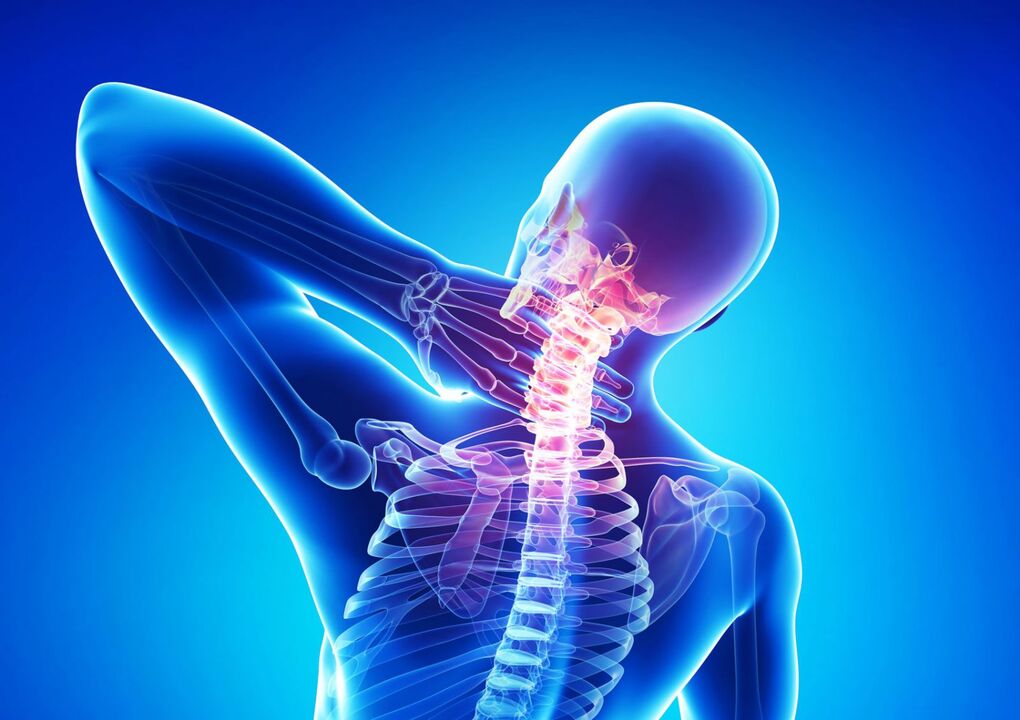Osteochondrosis in the neck in recent years has been found in people of different ages, including young people. Office workers, drivers and people who sit in front of computers for long periods of time are especially susceptible to this disease.
People over the age of 20 who do not pay due attention to their health and physical activity can develop osteoarthritis in the cervical spine, as a result of which the discs between the vertebrae begin to thicken and collapse, leading tonerve compression. terminal and artery.

What is dangerous neck osteoarthritis?
Cervical osteoarthritis is a disease that most adults have, but not everyone knows what it is really dangerous to do. Many nerve channels and circuits run along this part of the spine, responsible for delivering nutrients to the brain. In the neck region, the vertebrae are especially close together, so even a slight change in structure, nerve roots and blood vessels can be compressed.
In the context of cerebral circulatory disorders, various health problems can occur:
- migraines and severe headaches with cervical spondylosis;
- hypertension;
- vegetative vascular dystonia;
- cardiovascular disorders;
- pathology of the respiratory system;
- impaired vision, hearing and even coordination of movements.
In later forms of development, osteoarthritis in the neck, as shown in the photo, leads to vertebral artery syndrome. The latter is responsible for the blood supply to the cerebellum and nourishes the spinal cord. In this context, cerebral ischemia as well as spinal stroke can occur.

A bump on the neck with osteoarthritis can be a sign of a malignancy: see a doctor immediately!
Common degenerative joint disease in the cervical region can cause damage to the nerve endings:
- radiation sickness;
- loss of mobility of the head;
- the appearance of growths on the vertebrae.
To avoid serious complications, it is necessary to start treatment in a timely manner, which is impossible without a diagnosis.
X-ray to diagnose cervical spondylosis
Your doctor can identify cervical spondylosis on x-rays. For larger informational content, each part of the spine can be dimmed separately and at different angles. In such photos of cervical pathology, one can examine in detail and determine the extent of damage to the vertebrae.
Some doctors refer patients to so-called functional X-rays: the patient must take different positions to twist the spine to create an image of the neck. In rare cases, patients receive special injections of substances into the discs, arteries, or spinal canal. In this case, the X-ray conclusion will be given in the most accurate and detailed way.
ICD classification of cervical osteoarthritis
ICD 10 is the International Classification of Diseases, which in 2007 became the widely accepted guideline for assigning appropriate codes to various diseases. Osteochondrosis of the cervical region, 1998 ICD 10th code has M42, and several types of pathology have been assigned to it. To date, according to the ICD, the disease has been partially identified with other precancerous diseases in the range of M50 to M54. Depending on the pain syndrome, the disease is classified into:
- M50. 0 - osteonecrosis with myopathy;
- M50. 1 - with radiculopathy;
- M50. 2 - offset disk;
- M50. 3 - other pathologies of the neck;
- M50. 9 - unspecified diagnosis.
Types of cervical osteoarthritis
Review of the most common types of osteoarthritis of the cervical spine according to the ICD classification.
The convexity in the disease
Cervical spondylosis with disc protrusion is one of the most common complications. Disc protrusion is the initial stage of disc herniation, so it should not be underestimated. The main factors that cause the appearance of protrusions include:
- lack of amino acids in tissues;
- poor cell water supply;
- Low concentrations of trace elements in tissues.
The discs have a colloidal core, surrounded by a special fibrous ring. The weak supply of cells with useful components against the degenerative process of osteoarthritis causes damage to the fibrous ring, which will keep the mucous nucleus in the disc. Tissue pathologies occur with the formation of cracks in the ring and the penetration of colloids into the microcracks.
Brain syndrome
Doctors sometimes diagnose cervical spondylosis with renal syndrome in patients. It is determined by the patient's complaints such as:
- Tinnitus;
- heaviness in the head;
- pre-anesthesia and syncope states.
The combination of these symptoms indicates poor cerebral circulation, so the brain receives less oxygen to function properly. Other symptoms include drowsiness and occasional fever.
Osteochondrosis of the neck with displacement
Osteoarthritis of the cervical spine with displacement, which occurs in some patients, is one of the most common forms. The disease develops for a variety of reasons, including:
- congenital abnormalities;
- acquired trauma;
- diseases.
The displacement of the vertebrae contributes to narrowing of the spinal canal, causing pain and disrupting the functioning of various internal organs. If you have pain in your neck and suspect a displaced disc, you should see your doctor promptly, who will prescribe effective treatment.
Such spondylolisthesis, cervical disc misalignment and basal spondylolisthesis are often related disorders that require immediate and serious treatment.
Will they send me into the army if I have cervical osteoarthritis?
Many young conscripts suffer from an unpleasant illness for various reasons. Some are interested whether cervical spondylosis can be enlisted in the army?
We immediately note that at the initial stage of development this disease will not even allow you to rest, since it does not interfere with the service. With more advanced disease, pain syndrome and limitation of movement, the patient should be registered with a neurologist. The doctor's official conclusion will allow you to be pardoned, and in the most extreme cases, the young man can be declared unfit.
According to the law, it is impossible to serve in the army with the defeat of three vertebrae and herniation between the vertebrae of the cervical region.
Can I apply for a sick leave if I am diagnosed with osteoarthritis of the neck?
Now let's find out, with cervical spondylosis, do they get sick leave and for how long? It can actually be released, as serious bone pathologies can cause disc displacement, herniation, and other dangerous disorders.
You can get sick leave for cervical spondylosis if you do the following:
- Contact a neurologist who will make the appropriate diagnosis and certification.
- The doctor will diagnose and determine the possible health risk, taking into account the patient's work.
- When inpatient treatment according to regulations, sick leave will have one type, if the patient is assigned to take a few days off, he will receive another appointment letter.
With osteonecrosis, how many days of sick leave will be granted depends on several factors:
- in the early stages, sick leave can be given from 3 to 7 days if going to work does not aggravate the illness;
- in the more severe form, up to two weeks of sick leave may be required;
- with more severe lesions of the vertebrae, the patient can be treated for three months;
- a complex form with periarthritis and other syndromes is treated for up to 7 months and can function after being completely normal.
When surgery is needed to treat osteoarthritis, sick leave is issued taking into account the time of preparation and rehabilitation.
























